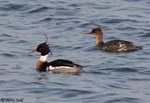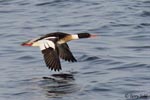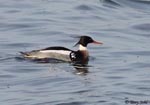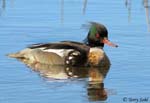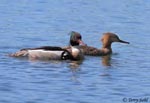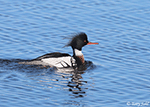| Length: 17 to 25 inches | Wingspan: 30 to 36 inches | Seasonality: Migrant |
| ID Keys: Reddish chest on male, gray sides, black head with white collar, thin serrated bill. | ||
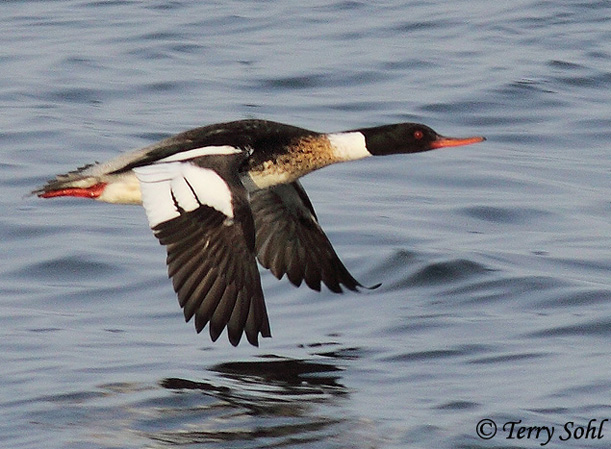 The Red-breasted Merganser is most often seen along coastlines
of the U.S. in the winter, as they prefer to winter on salt-water (unlike the Common
Merganser). They sometimes hunt cooperatively, forming lines to
drive small prey fish into shallow water. They are among the fastest of
all flying waterfowl, reaching speeds of up to 100 mph.
The Red-breasted Merganser is most often seen along coastlines
of the U.S. in the winter, as they prefer to winter on salt-water (unlike the Common
Merganser). They sometimes hunt cooperatively, forming lines to
drive small prey fish into shallow water. They are among the fastest of
all flying waterfowl, reaching speeds of up to 100 mph.
In South Dakota, Red-breasted Mergansers are migrants, more commonly found in the eastern part of the state than the west. They sometimes may be one of the earliest waterfowl to start to move northward through the state.
Habitat:
During breeding season, they are found around lakes and rivers in the forests of Northern North America, northward into the tundra. During winter, they are primarily found on coastal waters, with smaller numbers on inland waters if they are ice-free. Red-breasted Mergansers are more likely to be found in salt-water habitats than other merganser species in North America.
Diet:
Red-breasted Mergansers feed primarily on small fish. They will also take crustaceans, aquatic insects, frogs, and tadpoles. Young birds take insects and small crustaceans until they approach the adult's larger size.
Behavior:
Feeds by diving and pursuing prey underwater. Occasionally Red-breasted Mergansers appear to cooperatively, collectively driving small fish to shallower water for easier capture. They are very strong fliers, and are one of the fastest flying waterfowl in North America.
Breeding:
Non-breeder in South Dakota. On their breeding grounds, Red-breasted Mergansers nest on the ground, using a variety of locations as long as the nest site is near water. The nest is placed in a protected area such as at the base of a dense bush, nest to or under a brush pile, under a fallen log, are in a protected spot in a rocky crevice. The nest is a shallow scrape, lined with dead grasses and weedstems, and finished with down. The female lays between 4 and 16 eggs, and she alone incubates them. The young hatch after about four weeks, and leave the nest soon after hatching. The female protects the young while they gather their own food. The male is nowhere to be soon once the nest site is selected and all eggs have been laid.
Song:
Generally silent, although the courting male will make cat-like calls.
- Click here to hear the croaking flight calls of a Red-breasted Merganser1
- Click here to hear the calls of a courting male Red-breasted Merganser2
Migration:
Summers throughout Alaska, much of Canada, the Great Lakes region, and New England. Winters along both the Atlantic and Pacific coasts of North America, with much smaller numbers over-wintering on the Great Lakes and other inland water bodies.
Interactive eBird Map:
Click here to access an interactive eBird map of Red-breasted Merganser sightings
Similar Species:
Females are generally more of an identification challenge than are the male Red-breasted Mergansers. Potential confusion could be with the other merganser species possibly found in South Dakota:
- Common
Merganser - While somewhat similar in size and general shape, male Common
Mergansers are quite easy to differentiate from male Red-breasted
Mergansers. Male Common Mergansers have a much simpler plumage pattern,
with a dark head and neck and dark back, with a clear demarcation
between the dark plumage and the starkly white flanks, breast, and
belly. In comparison, male Red-breasted Mergansers have a more complex
pattern, with a rusty mottled breast, a dark back and head, white neck
band, and a grayish, vermiculated looking flank. Male Common Mergansers
also have a much "cleaner" looking head, without the shaggy crest
feathers often seen on Red-breasted Merganser males. On both males and
females, the bill of a Common Merganser is shorter and more robust than
the longer, thinner bill of a Red-breasted Merganser.
Female Common Mergansers have a rusty head and neck, with a very sharp demarcation to a white breast. They also have a diagnostic white chin patch. Female Red-breasted Mergansers are more "messy" looking in appearance, with more gradual transitions between brownish color tones on the head, and grayish tones on the body. - Hooded Merganser - Hooded Mergansers are a substantially smaller species, with a much shorter bill than a Red-breasted Merganser. Male Hooded Mergansers have a unique plumage that's easily differentiated from a male Red-breasted Merganser, with the trademark black-and-white "hood", white breast, black and white barring on the front flank, and rusty colored flanks. Compare to male Red-breasted Merganser with a rusty breast, and grayish flanks. Size, shorter bill, and overall browner tones on the female Hooded Merganser differentiate it from the female Red-breasted Merganser.
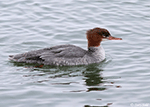 |
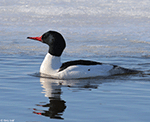 |
 |
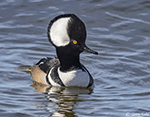 |
| Common Merganser (female) | Common Merganser (male) | Hooded Merganser (female and young) | Hooded Merganser |
Conservation Status:
Systematic surveys in recent decades show populations of Red-breasted Merganser are generally stable. They are found across a very broad geographic area, and are common in parts of that range. The IUCN considers the Red-breasted Merganser to be a species of "Least Concern".
Further Information:
- USGS Patuxent Bird Identification InfoCenter, Red-breasted Merganser
- Audubon Guide - Red-breasted Merganser
- Whatbird.com: Red-breasted Merganser
Photo Information:
Photo taken on April 12th, 2012 - Sachuest National Wildlife Refuge, Rhode Island - Terry Sohl
Audio File Credits:
- 1Lars Edenius. Recorded in Sweden on May 8th, 2020. Original recording and information available from xeno-canto.
- 2Stein O. Nilsen. Recorded in Norway on March 2nd, 2019. Original recording and information available from xeno-canto.
| Click on the map below for a higher-resolution view |
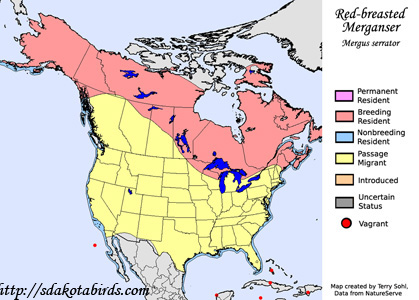 |
| South Dakota Status: Uncommon migrant in the eastern half of the state, rare migrant in the west. Rare winter visitor along the Missouri River. |
Additional Red-breasted Merganser Photos
Click for a higher-resolution version of these photos
